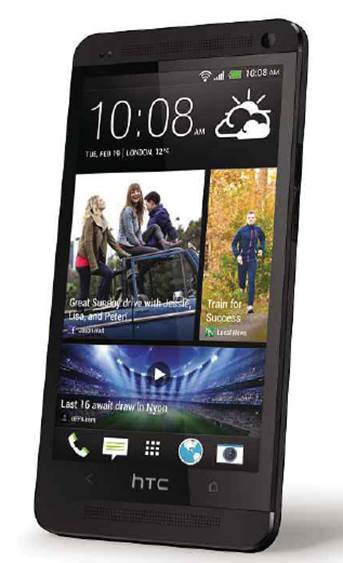This is the One, but is it the one for you?
As a maker of phones,
HTC seems to oscillate disturbingly between hitting the nail firmly on the head
and giving itself a one-way ticket to accident and emergency.
The Dire and Wildfire
were ground breaking in their era, but the Sensation and Rhyme were less
inspiring. The One X and One S were nice designs, but doomed to go up against
the unstoppable force of the Samsung Galaxy S3. With these things in mind, that
it’s come back with another seminal design- in the form of this phone, the HTC
One- serves as confirmation of its creator’s gritty determination.

HTC One 32GB
Given that HTC has
already released phones called the One X, One S and One V, it’s not without a
degree of confusion that this new design is called ‘One’, like it was the
origin of those others. In fact, this phone is specifically a successor to the
One X, and is aimed squarely at reminding Samsung owners that there are other
Android phone makers in the world.
It’s heavier than any
of the other One series, weighing 143 grams, but also has highest resolution
screen of the range, too- a particularly outstanding a 4.7’, 1080p Super LCD 3
coated in Corning’s Gorilla Glass, which takes the ‘retinal’ iPhone 5’s 326ppi
display, and knocks it to the canvas with a 468 counter-punch. Computing power
comes from the latest, feisty Qualcomm Snapdragon 600 design. This is also the
CPU of choice in the Samsung Galaxy S4, and the new Asus Padfone Infinity, so
HTC is in good company. The One’s the ARM-based CPU is running at 1.7GHz and is
coupled with the Adreno 320 GPU and 2GB of RAM. Internal storage is either 32
or 64GN, with this review model providing the smaller of those two options.

It has highest resolution screen of the
range, too- a particularly outstanding a 4.7’, 1080p Super LCD 3 coated in
Corning’s Gorilla Glass, which takes the ‘retinal’ iPhone 5’s 326ppi display,
and knocks it to the canvas with a 468 counter-punch.
With that much power
available, a decent battery was a necessity, and encased in the impenetrable
shell is a 2300 mAh Lithium power pack. This gives enough juice for a decent
working day, or it will do if you avoid signing up to EE’s LTE service, which
might drain it significantly faster.
Like the One X, I was
again disappointed that the battery isn’t user replaceable, but equally I can
see that no having removable panels does make the phone that much more robust.
They have also passed on allowing you to expand storage with a MicroSD,
probably for the same reason.to get a better handle on the performance
available I used the new 3DMark for Android to score the video. The One managed
a very respectable 10027 on the OpenGL ES 2.0 Ice Storm Test, compared with
7940 on my Nexus 10 tablet. That’s marginally lower scoring than the Samsung
Galaxy S4, but not enough to make a substantial difference to the user
experience.

The One managed a very respectable 10027
on the OpenGL ES 2.0 Ice Storm Test, compared with 7940 on my Nexus 10 tablet.
That’s marginally lower scoring than the Samsung Galaxy S4, but not enough to
make a substantial difference to the user experience.
It’s never all about
power, though, and when using the One it doesn’t take long to realize that HTC
is determined to tweak the Jellybean OS to its own preferences. The One
incorporates Sense 5.0, a series of custom interface changes that is unique to
HTC. In practice I means that upon launching into Android on the One, you’re
presented a slightly odd combination; something like the spawn of Windows
Mobile and a conventional Android Jelly Bean experience. The first page has
live tiles and can be vertically scrolled to reveal extra ones, while dragging
sideways reveals the normal Android desktop. On these screens you can place
your own widgets. Like the Microsoft tiled interface.
I found it something
of an acquired taste, but it’s certainly a departure from what Sony and Samsung
are doing. The focus is on users if social networks. For those that don’t use
them, though, it might seem rather superfluous.

There are plenty of interesting
real-time filters, HDR and even slow motion capture in video mode, but I’ve
seen better results from other, older phones.
The camera is nice,
but nothing special. It’s has a modest, by current standards, 4MP sensor,
though the sensor is physically bigger than phones normally carry. As I have a
6MP Nikon D50 that takes great images, I understand the theory, but in practice
the pictures didn’t support the hypothesis.
“HTC has come back with another seminal
design – in the form of this phone”
There are plenty of
interesting real-time filters, HDR and even slow motion capture in video mode,
but I’ve seen better results from other, older phones.
One feature that did
deliver was the front mounted speakers, which leave the impression that this is
the loudest phone I’ve ever tested. They’re remarkably distortion- free, and if
you can miss a call with this in your pocket you ought to be thinking about
booking a hearing test.

HTC has come back with another seminal
design – in the form of this phone
After using the One
for a week, the lasting impression will be of its sheer power, embodied by its
very bold screen, which comes nicely wrapped in HTC’s signature all-metal
chassis. Should you buy one? That’s a tough call with the Nexus 4 costing just
$392.6. This is built to a much higher specification, but I’m not sure it’s
twice as good.
The best HTC phone there’s been for a
while if you can afford one.
Good points
·
Powerful
Processor
·
Top
quality construction
·
1080p
screen
·
Stereo
speakers
Bad points
·
Very
average Camera
·
No
memory slot
·
No
battery replacement.
|
Details
·
Price: $800.25
·
Manufacturer: HTC
·
Website: www.htc.com
Ratings
·
Quality: 8/10
·
Value: 7/10
·
Overall: 8/10
|